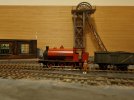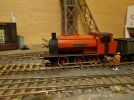Pretty straight forward is track building once you get the hang of it. Lots of people do things differently but this is my approach.
Tools I use.
Emgs vee & blade filing jigs.
Roller gauges
Triangle gauges
A large course file
A smaller finer file
Sand paper & polishing paper.
Sticky tape
Double sided tape
I use templot for drawing templates as this is simple. I can't draw layouts on that programme & after hours trying I gave up.
Once you have printed a template to gauge, smp kits usually have all the bits, rails, copperclad & a template ( a good start )
Lay you template on something flat, workbench, glass plate etc. Stick it down with some tape around the edges.
Cut your sleepers to length, I glue mine with a little pva glue. I leave it to set, if you use a tiny bit on a brush that cures quickly. I have used double sided tape equally as well but only on the edges of the sleepers. Take note where your tiebar is going to go & leave that out of the mix. I make mine as a sleeper, some make a tiebar separate. The glue btw is used so that when the turnout is made it can be boiled off with a kettle full of water. It goes a bit squishy under the sleeper but you can move it by rubbing it with your finger.
When you use the filing jig it has 4 angles which work with the templates, when you slip the rail take note of which side up it goes. You need to file 2 lengths & to make it work in the jig for soldering the lengths need to be opposite ways round in the jig. What I mean by that is one rail with the bullhead to the top & the other to the bottom.
Once they are filed flat, unscrew the jig & slot both rails into the vee section of the jig. Line them up so they meet perfectly & tighten the screw once again & solder.
That's it vee done.
If you bought the blade filing jig then it's much the same process by making sure the 2 rails lay in the jig with both bullhead pieces facing in or out, it doesn't matter which. Just files the top & eventually it'll go nice & flat & you'll have 2 blades.
As you get swarf from filing I use sand papers to clean the blades & vee components so they are smooth before assembly. You don't want any friction when the blades move.
A good move btw is to print or photocopy a second template for reference.
I start by soldering the vee onto the template, others will do it different but it's up to you. I then cut my stock rails & mark where the point blades will touch the rail. I mark the side of the rail woth a marker pen & then I file it back so the rail is smooth & not bullhead or base is showing. In essence you halve the thickness of the rail. This helps the point blade sit snugly against the stock rail.
I then solder a stock rail, starting at the vee end. Using roller gauges etc helps here. Do both of your stock rails as far as the vee. I then form the parts of rail leading into the vee. This is a tricky part & its better to form them with your separate template. Use a ruler to line them up with the vee & if you have all your jigs from the emgs you should have a length of steel. This is to check the flangeways. Stick that into the mix here too.
After those parts are fitted I usually work my way out one side at a time constantly checking with the gauges everything is to gauge. Keep an eye on the rail too, it can sit at an angle in a jig.
That's it in a nutshell, hopefully I've covered it a bit. The iain rice books are OK to help out. I've found it trial & error. Another good way to learn is join one of the emgs area groups.
I'd post pictures but I'm stuck on a loading bay in Bedford currently a few hundred miles away from the jigs








